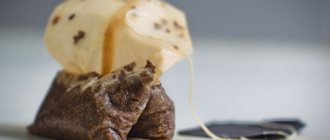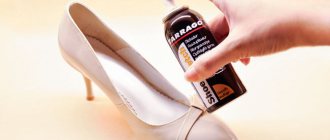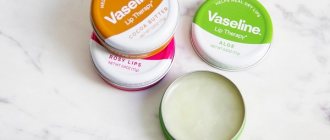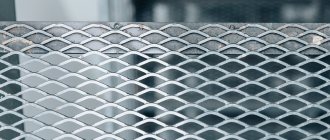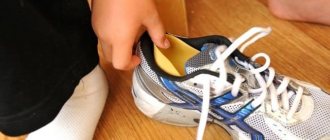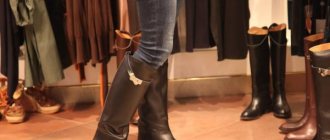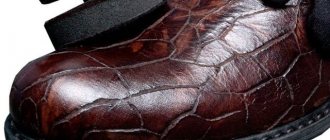Every person updates his wardrobe over time by buying new clothes and shoes. As for a leather pair, the heels can rub your feet, or the rough material does not allow you to sit comfortably on your feet and requires breaking in. Such problems can arise not only with new clothes, but also with old, worn-out shoes. Over time, the skin becomes hard and causes some discomfort. However, there is nothing terrible in this, since it can be solved. There are several proven ways to soften leather shoes.
Effective skin softening methods
One of the most effective ways to soften shoes is the military method. With its help, even products made from the roughest materials become soft. To do this you need to do the following:
- First, the couple is thoroughly moisturized from the inside.
- Afterwards, apply a soft wet cloth to the rough areas.
- The prepared areas are beaten with a regular hammer, applying a minimum of force.
- During the process, you need to periodically check the condition of the skin so that it does not become soft at all.
After drying, the shoes will become much softer and more comfortable. However, this method is not suitable for all products, or rather the materials from which they are made. For expensive designer shoes made of suede or patent leather, you should use more gentle methods.
Types of wearing discomfort
Most often, shoes or boots have to be broken in before wearing them permanently. It also happens that good leather shoes become stiff after a long period of wear.
Shoes made of leather or leatherette cause discomfort in typical places:
- in the back area;
- in a sock;
- in the middle part;
- in the foot.
Depending on the location of the discomfort, different methods are used to make the shoes softer. When using this or that product, pay attention to the skin type and the presence of bright colored dyes.
Attention!
Before full processing, it is best to do a test application on the inner surface of the material. This will help you understand whether the shoes will be damaged during processing.
Use of special means
A good remedy for these purposes is ordinary alcohol. The procedure consists of several stages:
- The alcohol is evenly sprayed inside the shoes using a spray bottle.
- The roughest areas are additionally treated with a cotton pad soaked in alcohol.
- A few minutes after absorption, the pair needs to be spread so that it takes the desired shape.
Important! Before the procedure, it is recommended to slightly moisten a small area of the skin to check the interaction of alcohol with paint, as their combined use may cause a reaction, and the paint may peel off. If this happens, then the alcohol should be replaced with ordinary cologne.
To soften the skin, you can use castor oil and petroleum jelly; stores also sell special shoe creams, emulsions and gels.
Glycerol
An excellent product is glycerin for shoes, the use of which is advisable for any leather or suede pair. This is a universal remedy that can help in any situation. It contains alcohol, but the glycerin compound itself is not aggressive. Considering that the product is used as an additive for various special creams, glycerin for leather shoes is the most correct solution. Moreover, the effect of its use is considered to be maximum compared to other skin softeners. The method of using it is simple: just treat the problem area and let the substance absorb into the skin. After this, remove the remaining glycerin from the surface and then polish to restore the previous shine. As a result, even the roughest shoes become soft and comfortable to wear.
Wax
Wax has the same effect on leather products as paraffin. Its application is identical: the wax is melted to the desired consistency and the rough areas of the shoes are treated. A few minutes after hardening, the wax layer is carefully removed and the surface is polished.
Important! When heating wax, you need to be extremely careful, as at high temperatures it can damage the material.
Lard
Due to its fat content, lard is an excellent skin softener. You need to take fresh lard (not salted, smoked or boiled)! Directions for use: cut off a small piece of fatty lard and rub the entire surface of the shoe. Problem areas are treated again. Thanks to the properties of pork fat, the steam will become soft and retain its shine for a long time. Moreover, lard protects the surface of shoes from getting wet.
Natural lard or fat
This method allows you to soften the skin without harm and came from our grandparents, so there is no doubt about its effectiveness and reliability. Before you start processing the belt, you need to melt and cool the lard to room temperature.
The product is rubbed with fat over the entire surface and left to soak for several days. When all the fat has been absorbed, the leather belt is lubricated with baby cream with a moisturizing effect. After a couple of hours, excess cream must be removed with wet wipes.
Folk remedies and methods for softening the skin
There are several tips on how to soften leather on shoes at home.
You can use your usual home remedies. Hot air treatment is considered an effective method. To do this, use a hair dryer to dry your hair. With its help, the desired area of the product is heated by directing a stream of air at it, having previously set the required temperature. Steam has the same effect. Instead of steam, you can use boiling water, which should be poured into the shoes, left until the water begins to cool, then poured out. Afterwards, you should put on warm woolen socks and walk around in your shoes for half an hour. We recommend:
How to get rid of diesel smell on clothes using a washing machine
Softening with soap or paraffin
If you urgently need to soften leather shoes, then there is no better solution than soap. To do this, you need to thoroughly lubricate the shoe leather with a dry piece and leave it for 10 minutes, then wipe it with a dry cloth. Paraffin has the same effect. It is heated to a liquid state and lubricated on the problem area of the skin. After a few minutes have passed, the frozen plaque is carefully removed from the surface.
Using wet towels
A reliable and safe method of softening shoes or boots is to wrap them in a towel soaked in boiling water. To do this, wrap the shoes in a hot, damp cloth, wrap them in polyethylene on top and let them steam for 15 minutes. Afterwards, you should put on the shoes and walk in them for 30 minutes.
Features of softening shoes made of different materials
Suede is a capricious material. The use of oils and water on it is prohibited. To make it softer, you can use hot air. The best thing to do would be to take your boots made of natural suede to a shoe shop.
The surface of patent leather shoes is easy to damage. In this case, even the slightest scratches will be visible to the naked eye. For such a capricious material, you need to take a very rich cream. It should be applied evenly to the shoes and left overnight. Instead of cream, you can use lard.
You can make artificial leather softer using hot towels. Shoes should be placed in a box of a suitable size, wrapped in hot towels, and left for 12 hours. If necessary, the entire process should be repeated several times.
How to soften the heel of leather shoes
A common problem with new shoes is that the heel counter is too hard. Most people ignore this fact, and subsequently such walking ends in blisters. How to soften your shoes so they don't rub your heels:
- Softening backdrops with a hammer. This method involves beating the skin. There is no need to be particularly zealous, as you can damage the shoes, and some kind of impact-softening material should be applied to the heel.
- Using vinegar can also quickly soften shoe leather.
- Vegetable oil softens shoes, provided they are made from leather substitutes. Important! Under no circumstances should sunflower oil be used to soften leather products. This will only make them ruder!
If there is no time for such procedures, you can use pads made of soft material or fabric.
Rate this post
Regular Vaseline
To begin with, it is advised to test Vaseline on a small area of the belt and make sure that everything is in order with the product. If the effect is positive, rub the product into the surface of the product until completely absorbed.
Most often, this method is used for light-colored leather belts. A small drawback is that the effect of Vaseline is short-lived. You will need to repeat the procedure for several months, at least once a week, until the skin of the product is completely softened.
Castor oil
Castor oil has a good effect on the material. New shoes should be immediately treated with this oil and walked around a little.
Castor oil can soften the butt well, and sometimes works better than other home remedies.
For an even better effect, mix castor oil, melted beeswax and turpentine. All components are taken in equal quantities.
This composition is rubbed inside and out. Thanks to these products, the shoes are well saturated with oils, the leather becomes softer and more elastic.
In addition, this mixture protects against the negative effects of moisture. During rain, droplets of water will not be absorbed into the material; they will remain on the fabric in the form of droplets and then flow down onto the asphalt.
Getting rid of hard heels
An ordinary paraffin candle or laundry soap will help soften the backdrops a little. Rub one of these products on the inside of the heel of your shoe and try walking. You can also soften the backdrop with vinegar, generously moistening the skin in the problem area.
Alcohol diluted with water in a 1:1 ratio will help make artificial shoe materials soft. Moisten the backdrop with it and “break” it with your hands. Before the procedure, make sure that there is no cardboard insert in the heels; if it gets wet, it will get wet and the shoes will lose their shape.
Cold
To implement this method, you will need to fill a plastic bag with cold water. It is placed inside the shoes that need to be stretched and the shoes are placed in the freezer.
When water turns into ice, it increases in volume, which is what causes stretching.
Just make sure the bag has no holes and is tied well.
How to remove an ice pack? You can't pull by force. Remove the boots from the freezer and place them in a warm place. When the ice melts a little, you can easily take out the bag and try on the shoes already stretched.
Is it possible to return hard shoes to the store?
If you nevertheless purchased shoes or sneakers and after a walk you find that they are rubbing your feet, is it possible to return such shoes to the seller? Make no mistake, they will not be accepted back with such a claim. If no manufacturing defects are found on the shoes, which are revealed through examination, it is impossible to return them to the store after wearing them.
Factory defects in shoes can only be detected through a special examination.
Another case is also possible: you have not had time to wear the boots and the warranty period (14 days from the date of purchase) has not yet expired. The boots have not lost their consumer appearance, but you have already realized that they are made of rough leather and will rub your feet. Then try contacting the seller, present your unworn shoes, receipt, packaging, all labels and say that this product did not suit you in its shape, size, color, style, dimensions. There is a high probability that you will defend your rights and you will get your money back or be offered another product.
